Science of Consumer Behavior: Analysis of Motor Vehicle Choices
VerifiedAdded on 2022/11/14
|13
|2617
|170
Report
AI Summary
This report delves into the science of consumer behavior, specifically focusing on the cognitive processes behind motor vehicle purchasing decisions. It analyzes survey responses from three respondents, examining how their choices are influenced by personality traits and demographic factors. The study applies personality theories (trait and humanist) and demographic theories (cornucopian and demographic transition) to explain the respondents' preferences for different car models. The analysis reveals that factors such as price, brand, and vehicle features play varying roles in the decision-making process of each respondent. The report concludes by offering recommendations to motor vehicle marketers, suggesting strategies based on cognitive learning and memory theories to effectively target and attract specific customer segments. This includes understanding the customer's decision-making ability and emotions and encoding their desires and urges to purchase. This study aims to provide insights into the complexities of consumer behavior and its implications for marketing strategies.
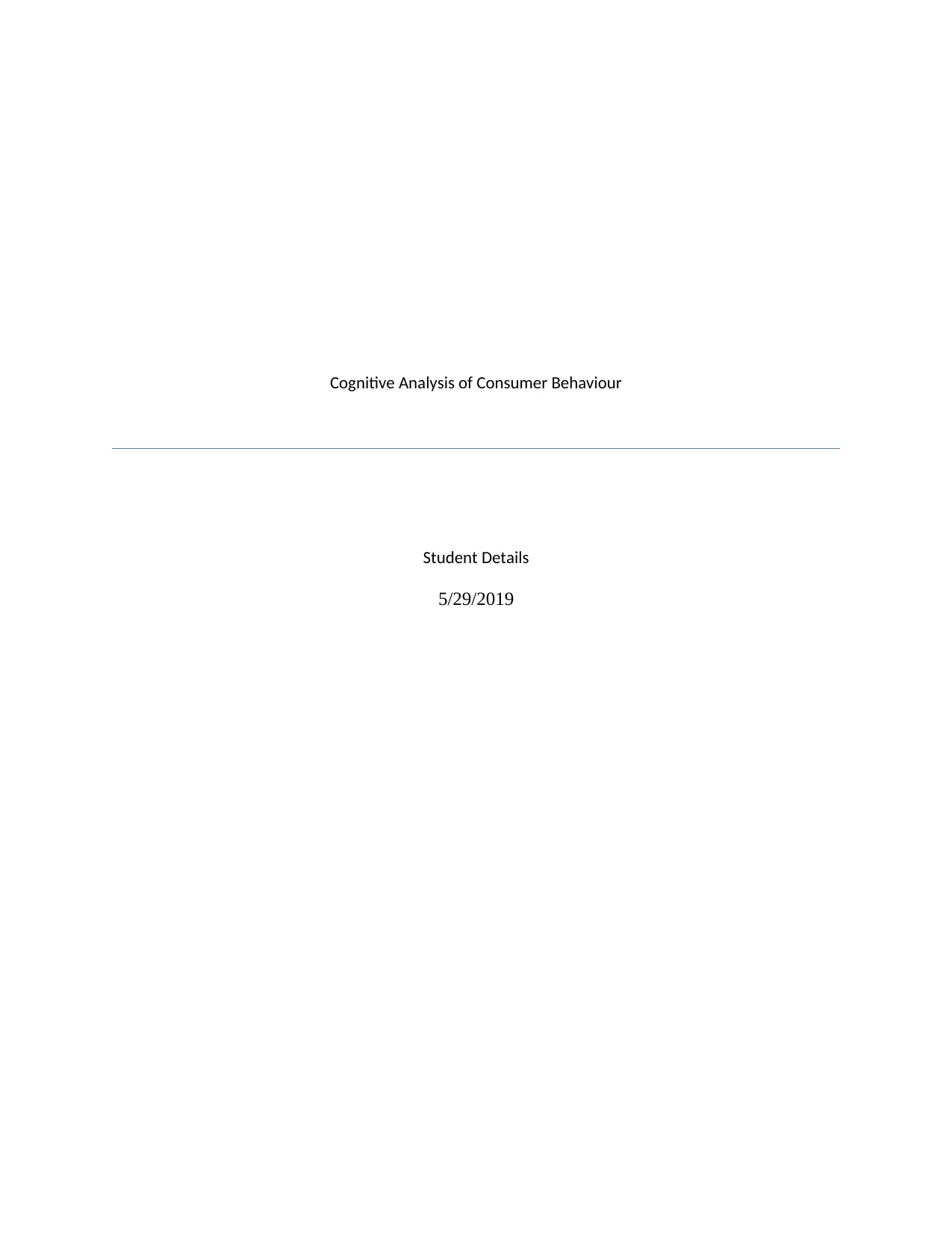
Cognitive Analysis of Consumer Behaviour
Student Details
5/29/2019
Student Details
5/29/2019
Paraphrase This Document
Need a fresh take? Get an instant paraphrase of this document with our AI Paraphraser
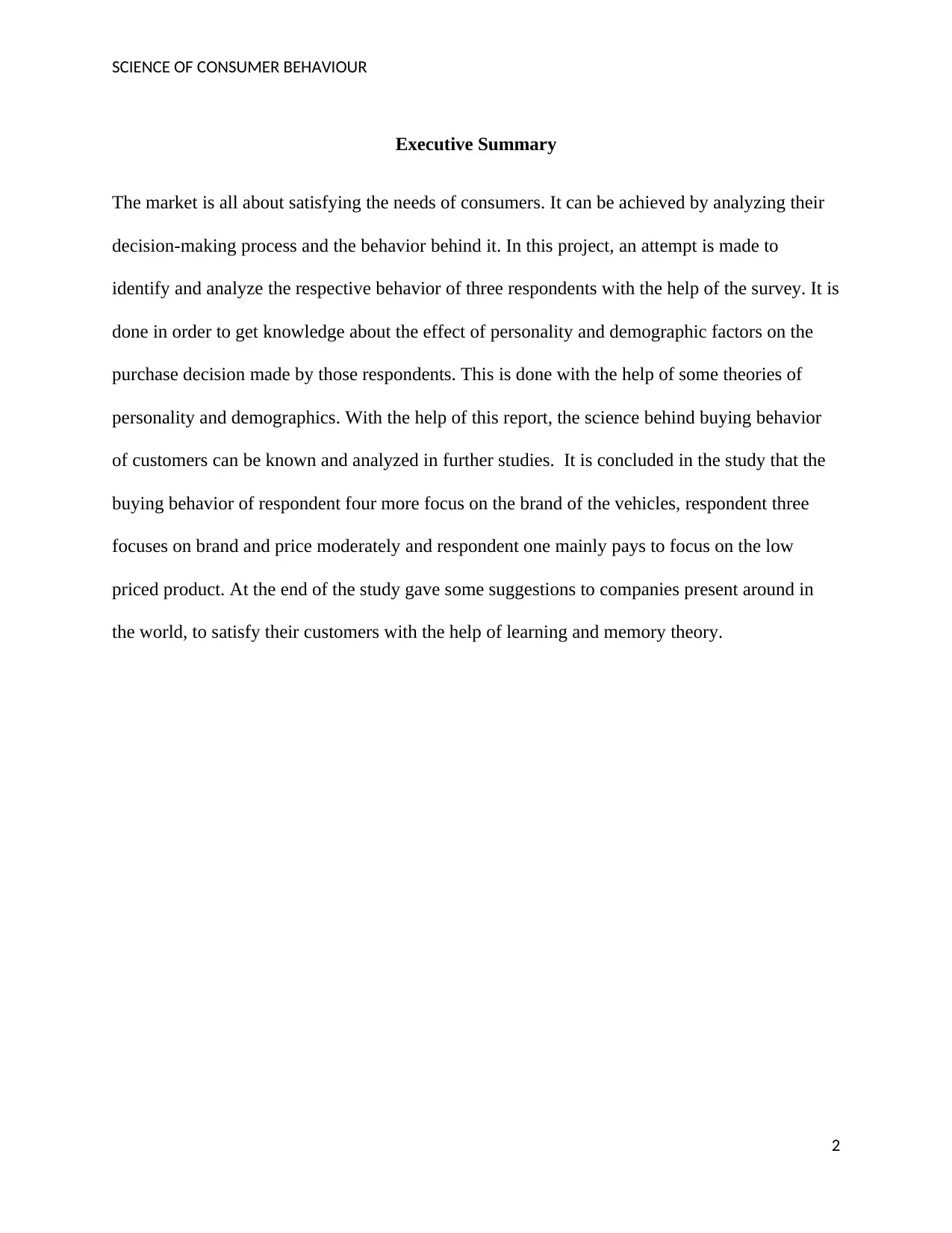
SCIENCE OF CONSUMER BEHAVIOUR
Executive Summary
The market is all about satisfying the needs of consumers. It can be achieved by analyzing their
decision-making process and the behavior behind it. In this project, an attempt is made to
identify and analyze the respective behavior of three respondents with the help of the survey. It is
done in order to get knowledge about the effect of personality and demographic factors on the
purchase decision made by those respondents. This is done with the help of some theories of
personality and demographics. With the help of this report, the science behind buying behavior
of customers can be known and analyzed in further studies. It is concluded in the study that the
buying behavior of respondent four more focus on the brand of the vehicles, respondent three
focuses on brand and price moderately and respondent one mainly pays to focus on the low
priced product. At the end of the study gave some suggestions to companies present around in
the world, to satisfy their customers with the help of learning and memory theory.
2
Executive Summary
The market is all about satisfying the needs of consumers. It can be achieved by analyzing their
decision-making process and the behavior behind it. In this project, an attempt is made to
identify and analyze the respective behavior of three respondents with the help of the survey. It is
done in order to get knowledge about the effect of personality and demographic factors on the
purchase decision made by those respondents. This is done with the help of some theories of
personality and demographics. With the help of this report, the science behind buying behavior
of customers can be known and analyzed in further studies. It is concluded in the study that the
buying behavior of respondent four more focus on the brand of the vehicles, respondent three
focuses on brand and price moderately and respondent one mainly pays to focus on the low
priced product. At the end of the study gave some suggestions to companies present around in
the world, to satisfy their customers with the help of learning and memory theory.
2
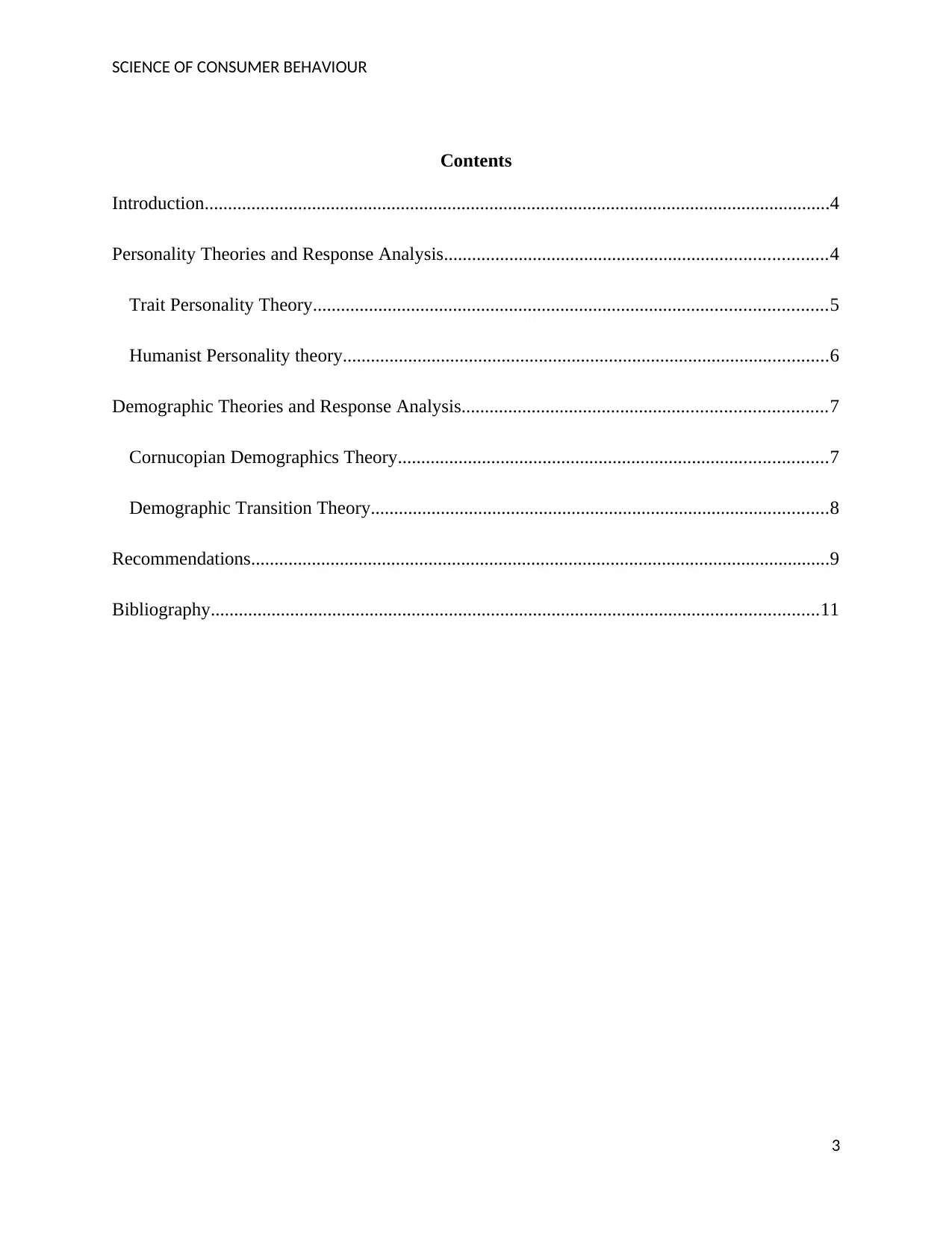
SCIENCE OF CONSUMER BEHAVIOUR
Contents
Introduction......................................................................................................................................4
Personality Theories and Response Analysis..................................................................................4
Trait Personality Theory..............................................................................................................5
Humanist Personality theory........................................................................................................6
Demographic Theories and Response Analysis..............................................................................7
Cornucopian Demographics Theory............................................................................................7
Demographic Transition Theory..................................................................................................8
Recommendations............................................................................................................................9
Bibliography..................................................................................................................................11
3
Contents
Introduction......................................................................................................................................4
Personality Theories and Response Analysis..................................................................................4
Trait Personality Theory..............................................................................................................5
Humanist Personality theory........................................................................................................6
Demographic Theories and Response Analysis..............................................................................7
Cornucopian Demographics Theory............................................................................................7
Demographic Transition Theory..................................................................................................8
Recommendations............................................................................................................................9
Bibliography..................................................................................................................................11
3
⊘ This is a preview!⊘
Do you want full access?
Subscribe today to unlock all pages.

Trusted by 1+ million students worldwide
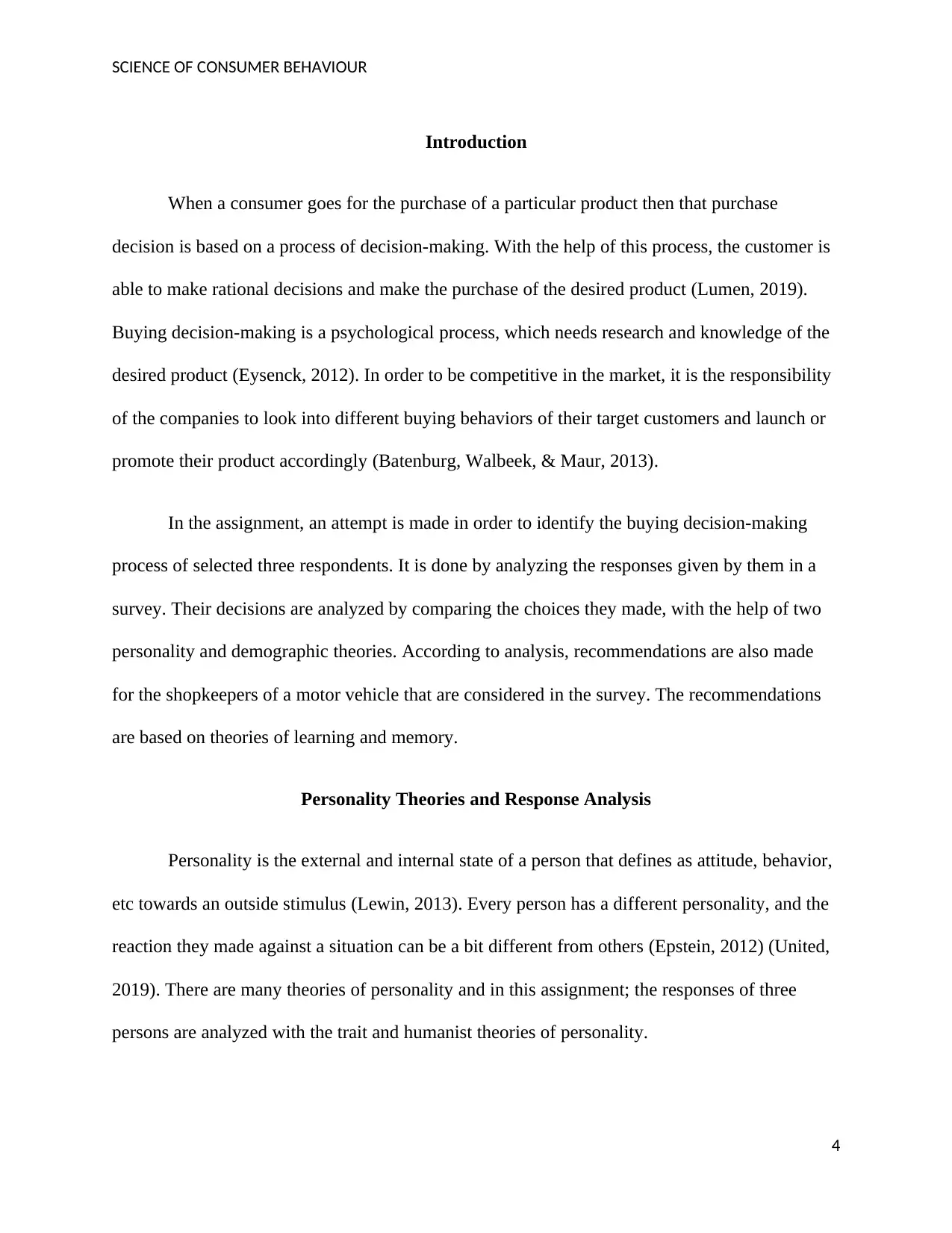
SCIENCE OF CONSUMER BEHAVIOUR
Introduction
When a consumer goes for the purchase of a particular product then that purchase
decision is based on a process of decision-making. With the help of this process, the customer is
able to make rational decisions and make the purchase of the desired product (Lumen, 2019).
Buying decision-making is a psychological process, which needs research and knowledge of the
desired product (Eysenck, 2012). In order to be competitive in the market, it is the responsibility
of the companies to look into different buying behaviors of their target customers and launch or
promote their product accordingly (Batenburg, Walbeek, & Maur, 2013).
In the assignment, an attempt is made in order to identify the buying decision-making
process of selected three respondents. It is done by analyzing the responses given by them in a
survey. Their decisions are analyzed by comparing the choices they made, with the help of two
personality and demographic theories. According to analysis, recommendations are also made
for the shopkeepers of a motor vehicle that are considered in the survey. The recommendations
are based on theories of learning and memory.
Personality Theories and Response Analysis
Personality is the external and internal state of a person that defines as attitude, behavior,
etc towards an outside stimulus (Lewin, 2013). Every person has a different personality, and the
reaction they made against a situation can be a bit different from others (Epstein, 2012) (United,
2019). There are many theories of personality and in this assignment; the responses of three
persons are analyzed with the trait and humanist theories of personality.
4
Introduction
When a consumer goes for the purchase of a particular product then that purchase
decision is based on a process of decision-making. With the help of this process, the customer is
able to make rational decisions and make the purchase of the desired product (Lumen, 2019).
Buying decision-making is a psychological process, which needs research and knowledge of the
desired product (Eysenck, 2012). In order to be competitive in the market, it is the responsibility
of the companies to look into different buying behaviors of their target customers and launch or
promote their product accordingly (Batenburg, Walbeek, & Maur, 2013).
In the assignment, an attempt is made in order to identify the buying decision-making
process of selected three respondents. It is done by analyzing the responses given by them in a
survey. Their decisions are analyzed by comparing the choices they made, with the help of two
personality and demographic theories. According to analysis, recommendations are also made
for the shopkeepers of a motor vehicle that are considered in the survey. The recommendations
are based on theories of learning and memory.
Personality Theories and Response Analysis
Personality is the external and internal state of a person that defines as attitude, behavior,
etc towards an outside stimulus (Lewin, 2013). Every person has a different personality, and the
reaction they made against a situation can be a bit different from others (Epstein, 2012) (United,
2019). There are many theories of personality and in this assignment; the responses of three
persons are analyzed with the trait and humanist theories of personality.
4
Paraphrase This Document
Need a fresh take? Get an instant paraphrase of this document with our AI Paraphraser
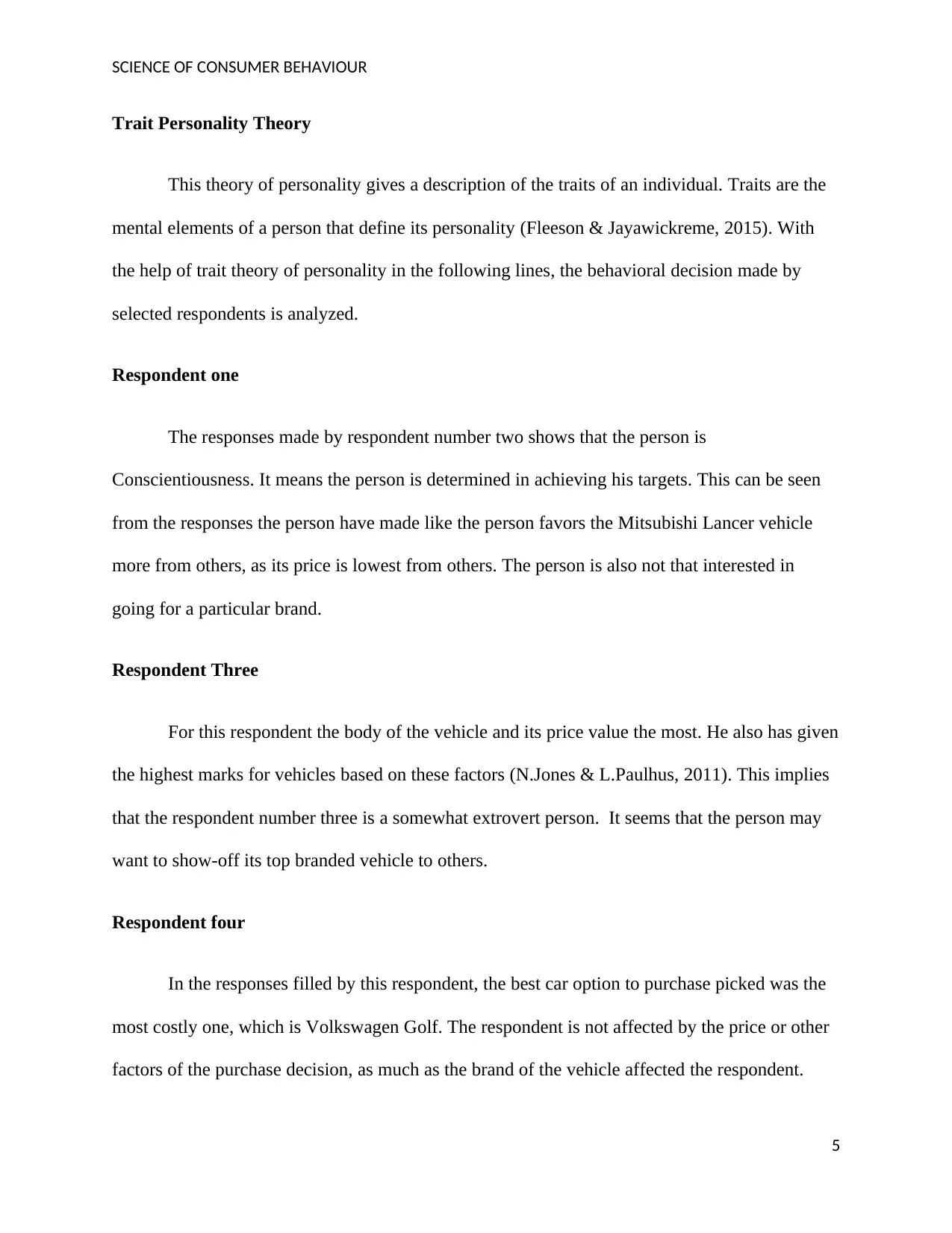
SCIENCE OF CONSUMER BEHAVIOUR
Trait Personality Theory
This theory of personality gives a description of the traits of an individual. Traits are the
mental elements of a person that define its personality (Fleeson & Jayawickreme, 2015). With
the help of trait theory of personality in the following lines, the behavioral decision made by
selected respondents is analyzed.
Respondent one
The responses made by respondent number two shows that the person is
Conscientiousness. It means the person is determined in achieving his targets. This can be seen
from the responses the person have made like the person favors the Mitsubishi Lancer vehicle
more from others, as its price is lowest from others. The person is also not that interested in
going for a particular brand.
Respondent Three
For this respondent the body of the vehicle and its price value the most. He also has given
the highest marks for vehicles based on these factors (N.Jones & L.Paulhus, 2011). This implies
that the respondent number three is a somewhat extrovert person. It seems that the person may
want to show-off its top branded vehicle to others.
Respondent four
In the responses filled by this respondent, the best car option to purchase picked was the
most costly one, which is Volkswagen Golf. The respondent is not affected by the price or other
factors of the purchase decision, as much as the brand of the vehicle affected the respondent.
5
Trait Personality Theory
This theory of personality gives a description of the traits of an individual. Traits are the
mental elements of a person that define its personality (Fleeson & Jayawickreme, 2015). With
the help of trait theory of personality in the following lines, the behavioral decision made by
selected respondents is analyzed.
Respondent one
The responses made by respondent number two shows that the person is
Conscientiousness. It means the person is determined in achieving his targets. This can be seen
from the responses the person have made like the person favors the Mitsubishi Lancer vehicle
more from others, as its price is lowest from others. The person is also not that interested in
going for a particular brand.
Respondent Three
For this respondent the body of the vehicle and its price value the most. He also has given
the highest marks for vehicles based on these factors (N.Jones & L.Paulhus, 2011). This implies
that the respondent number three is a somewhat extrovert person. It seems that the person may
want to show-off its top branded vehicle to others.
Respondent four
In the responses filled by this respondent, the best car option to purchase picked was the
most costly one, which is Volkswagen Golf. The respondent is not affected by the price or other
factors of the purchase decision, as much as the brand of the vehicle affected the respondent.
5
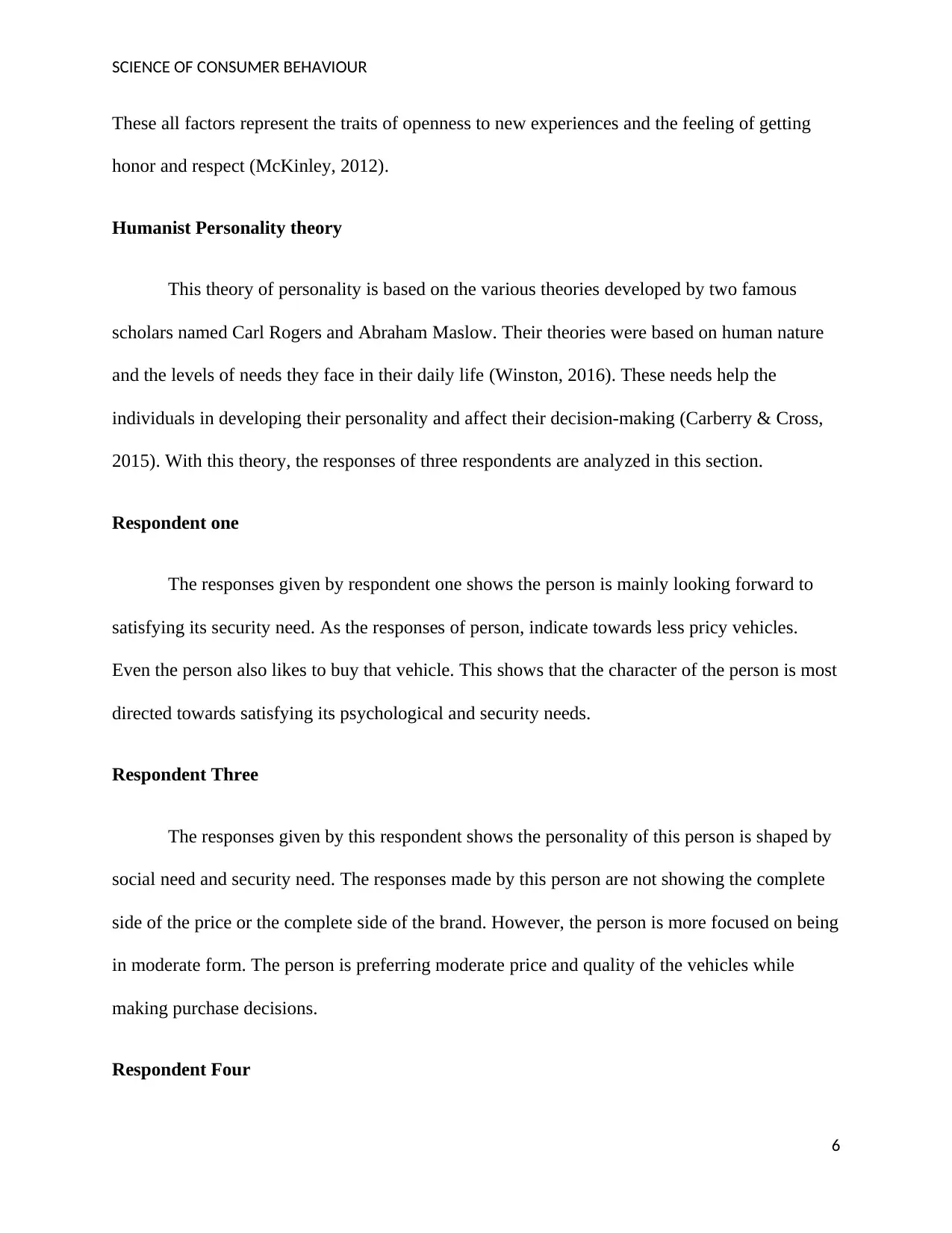
SCIENCE OF CONSUMER BEHAVIOUR
These all factors represent the traits of openness to new experiences and the feeling of getting
honor and respect (McKinley, 2012).
Humanist Personality theory
This theory of personality is based on the various theories developed by two famous
scholars named Carl Rogers and Abraham Maslow. Their theories were based on human nature
and the levels of needs they face in their daily life (Winston, 2016). These needs help the
individuals in developing their personality and affect their decision-making (Carberry & Cross,
2015). With this theory, the responses of three respondents are analyzed in this section.
Respondent one
The responses given by respondent one shows the person is mainly looking forward to
satisfying its security need. As the responses of person, indicate towards less pricy vehicles.
Even the person also likes to buy that vehicle. This shows that the character of the person is most
directed towards satisfying its psychological and security needs.
Respondent Three
The responses given by this respondent shows the personality of this person is shaped by
social need and security need. The responses made by this person are not showing the complete
side of the price or the complete side of the brand. However, the person is more focused on being
in moderate form. The person is preferring moderate price and quality of the vehicles while
making purchase decisions.
Respondent Four
6
These all factors represent the traits of openness to new experiences and the feeling of getting
honor and respect (McKinley, 2012).
Humanist Personality theory
This theory of personality is based on the various theories developed by two famous
scholars named Carl Rogers and Abraham Maslow. Their theories were based on human nature
and the levels of needs they face in their daily life (Winston, 2016). These needs help the
individuals in developing their personality and affect their decision-making (Carberry & Cross,
2015). With this theory, the responses of three respondents are analyzed in this section.
Respondent one
The responses given by respondent one shows the person is mainly looking forward to
satisfying its security need. As the responses of person, indicate towards less pricy vehicles.
Even the person also likes to buy that vehicle. This shows that the character of the person is most
directed towards satisfying its psychological and security needs.
Respondent Three
The responses given by this respondent shows the personality of this person is shaped by
social need and security need. The responses made by this person are not showing the complete
side of the price or the complete side of the brand. However, the person is more focused on being
in moderate form. The person is preferring moderate price and quality of the vehicles while
making purchase decisions.
Respondent Four
6
⊘ This is a preview!⊘
Do you want full access?
Subscribe today to unlock all pages.

Trusted by 1+ million students worldwide
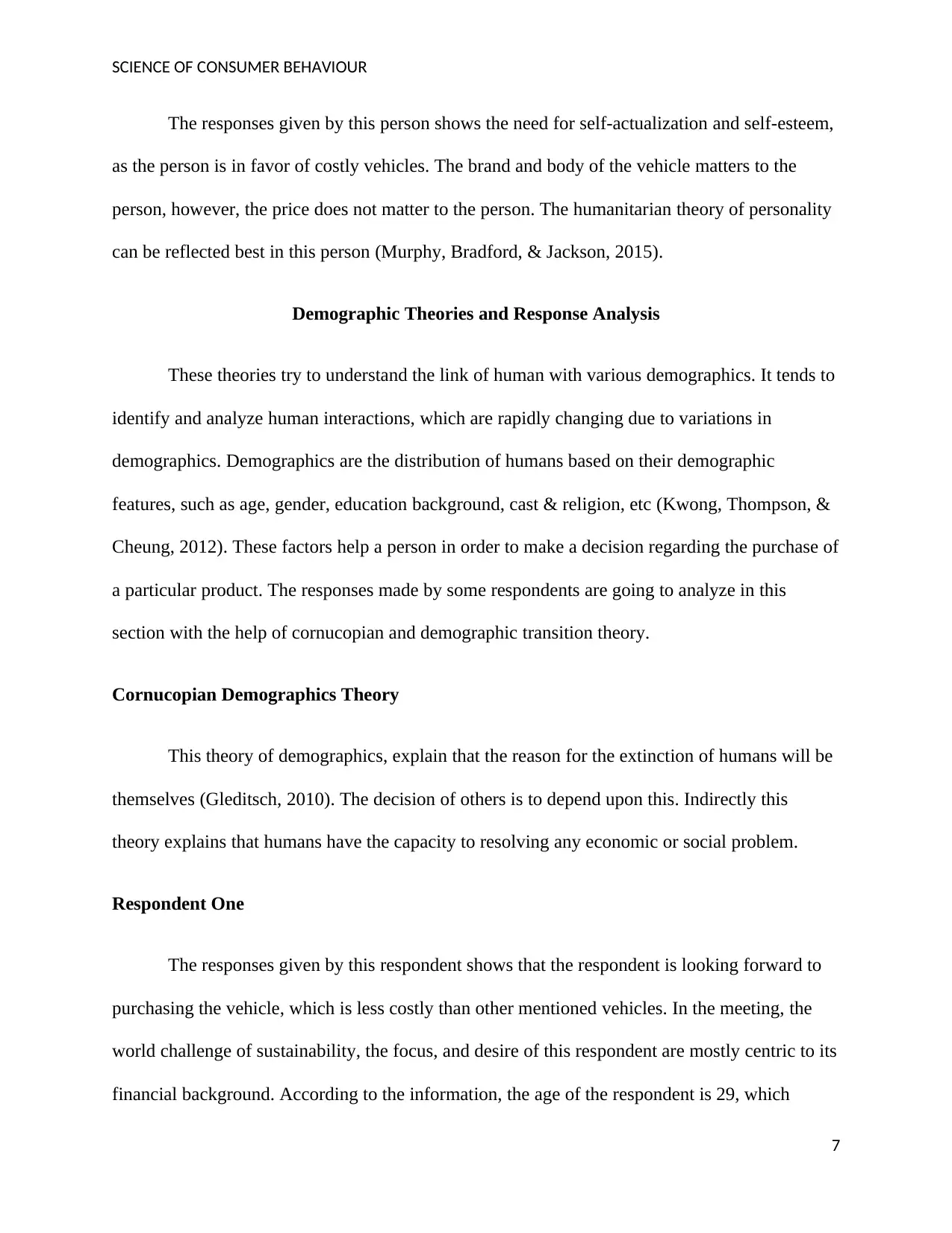
SCIENCE OF CONSUMER BEHAVIOUR
The responses given by this person shows the need for self-actualization and self-esteem,
as the person is in favor of costly vehicles. The brand and body of the vehicle matters to the
person, however, the price does not matter to the person. The humanitarian theory of personality
can be reflected best in this person (Murphy, Bradford, & Jackson, 2015).
Demographic Theories and Response Analysis
These theories try to understand the link of human with various demographics. It tends to
identify and analyze human interactions, which are rapidly changing due to variations in
demographics. Demographics are the distribution of humans based on their demographic
features, such as age, gender, education background, cast & religion, etc (Kwong, Thompson, &
Cheung, 2012). These factors help a person in order to make a decision regarding the purchase of
a particular product. The responses made by some respondents are going to analyze in this
section with the help of cornucopian and demographic transition theory.
Cornucopian Demographics Theory
This theory of demographics, explain that the reason for the extinction of humans will be
themselves (Gleditsch, 2010). The decision of others is to depend upon this. Indirectly this
theory explains that humans have the capacity to resolving any economic or social problem.
Respondent One
The responses given by this respondent shows that the respondent is looking forward to
purchasing the vehicle, which is less costly than other mentioned vehicles. In the meeting, the
world challenge of sustainability, the focus, and desire of this respondent are mostly centric to its
financial background. According to the information, the age of the respondent is 29, which
7
The responses given by this person shows the need for self-actualization and self-esteem,
as the person is in favor of costly vehicles. The brand and body of the vehicle matters to the
person, however, the price does not matter to the person. The humanitarian theory of personality
can be reflected best in this person (Murphy, Bradford, & Jackson, 2015).
Demographic Theories and Response Analysis
These theories try to understand the link of human with various demographics. It tends to
identify and analyze human interactions, which are rapidly changing due to variations in
demographics. Demographics are the distribution of humans based on their demographic
features, such as age, gender, education background, cast & religion, etc (Kwong, Thompson, &
Cheung, 2012). These factors help a person in order to make a decision regarding the purchase of
a particular product. The responses made by some respondents are going to analyze in this
section with the help of cornucopian and demographic transition theory.
Cornucopian Demographics Theory
This theory of demographics, explain that the reason for the extinction of humans will be
themselves (Gleditsch, 2010). The decision of others is to depend upon this. Indirectly this
theory explains that humans have the capacity to resolving any economic or social problem.
Respondent One
The responses given by this respondent shows that the respondent is looking forward to
purchasing the vehicle, which is less costly than other mentioned vehicles. In the meeting, the
world challenge of sustainability, the focus, and desire of this respondent are mostly centric to its
financial background. According to the information, the age of the respondent is 29, which
7
Paraphrase This Document
Need a fresh take? Get an instant paraphrase of this document with our AI Paraphraser
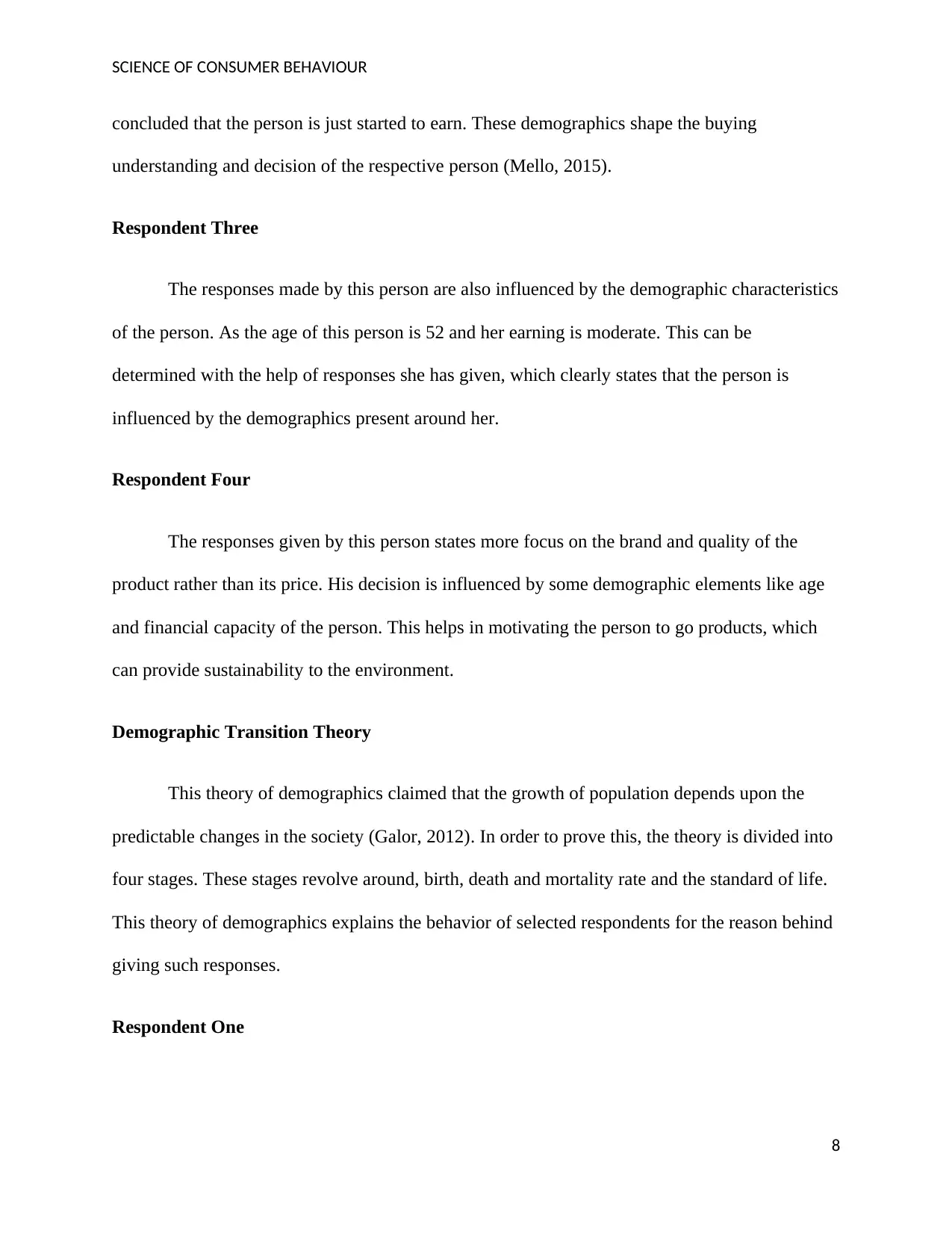
SCIENCE OF CONSUMER BEHAVIOUR
concluded that the person is just started to earn. These demographics shape the buying
understanding and decision of the respective person (Mello, 2015).
Respondent Three
The responses made by this person are also influenced by the demographic characteristics
of the person. As the age of this person is 52 and her earning is moderate. This can be
determined with the help of responses she has given, which clearly states that the person is
influenced by the demographics present around her.
Respondent Four
The responses given by this person states more focus on the brand and quality of the
product rather than its price. His decision is influenced by some demographic elements like age
and financial capacity of the person. This helps in motivating the person to go products, which
can provide sustainability to the environment.
Demographic Transition Theory
This theory of demographics claimed that the growth of population depends upon the
predictable changes in the society (Galor, 2012). In order to prove this, the theory is divided into
four stages. These stages revolve around, birth, death and mortality rate and the standard of life.
This theory of demographics explains the behavior of selected respondents for the reason behind
giving such responses.
Respondent One
8
concluded that the person is just started to earn. These demographics shape the buying
understanding and decision of the respective person (Mello, 2015).
Respondent Three
The responses made by this person are also influenced by the demographic characteristics
of the person. As the age of this person is 52 and her earning is moderate. This can be
determined with the help of responses she has given, which clearly states that the person is
influenced by the demographics present around her.
Respondent Four
The responses given by this person states more focus on the brand and quality of the
product rather than its price. His decision is influenced by some demographic elements like age
and financial capacity of the person. This helps in motivating the person to go products, which
can provide sustainability to the environment.
Demographic Transition Theory
This theory of demographics claimed that the growth of population depends upon the
predictable changes in the society (Galor, 2012). In order to prove this, the theory is divided into
four stages. These stages revolve around, birth, death and mortality rate and the standard of life.
This theory of demographics explains the behavior of selected respondents for the reason behind
giving such responses.
Respondent One
8
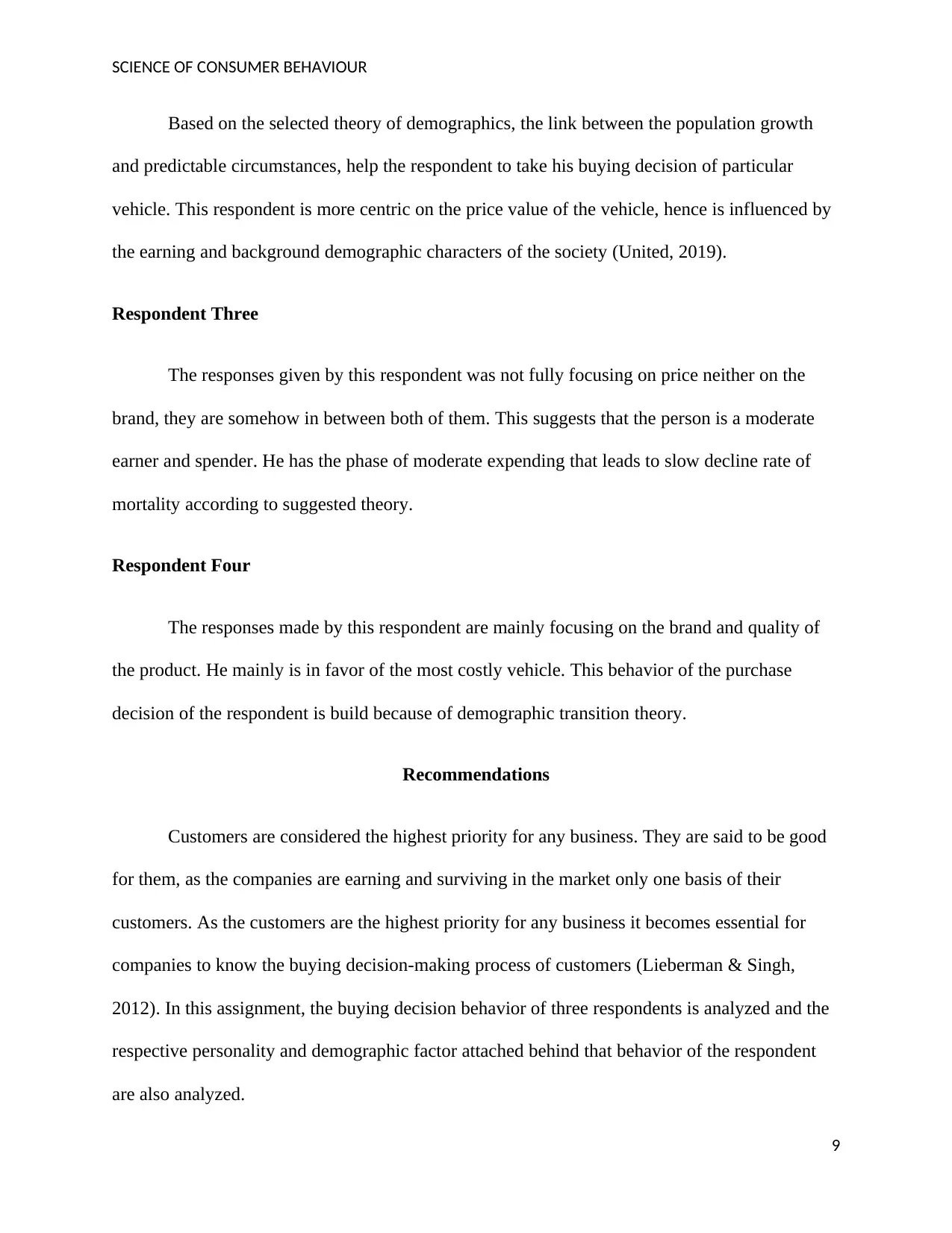
SCIENCE OF CONSUMER BEHAVIOUR
Based on the selected theory of demographics, the link between the population growth
and predictable circumstances, help the respondent to take his buying decision of particular
vehicle. This respondent is more centric on the price value of the vehicle, hence is influenced by
the earning and background demographic characters of the society (United, 2019).
Respondent Three
The responses given by this respondent was not fully focusing on price neither on the
brand, they are somehow in between both of them. This suggests that the person is a moderate
earner and spender. He has the phase of moderate expending that leads to slow decline rate of
mortality according to suggested theory.
Respondent Four
The responses made by this respondent are mainly focusing on the brand and quality of
the product. He mainly is in favor of the most costly vehicle. This behavior of the purchase
decision of the respondent is build because of demographic transition theory.
Recommendations
Customers are considered the highest priority for any business. They are said to be good
for them, as the companies are earning and surviving in the market only one basis of their
customers. As the customers are the highest priority for any business it becomes essential for
companies to know the buying decision-making process of customers (Lieberman & Singh,
2012). In this assignment, the buying decision behavior of three respondents is analyzed and the
respective personality and demographic factor attached behind that behavior of the respondent
are also analyzed.
9
Based on the selected theory of demographics, the link between the population growth
and predictable circumstances, help the respondent to take his buying decision of particular
vehicle. This respondent is more centric on the price value of the vehicle, hence is influenced by
the earning and background demographic characters of the society (United, 2019).
Respondent Three
The responses given by this respondent was not fully focusing on price neither on the
brand, they are somehow in between both of them. This suggests that the person is a moderate
earner and spender. He has the phase of moderate expending that leads to slow decline rate of
mortality according to suggested theory.
Respondent Four
The responses made by this respondent are mainly focusing on the brand and quality of
the product. He mainly is in favor of the most costly vehicle. This behavior of the purchase
decision of the respondent is build because of demographic transition theory.
Recommendations
Customers are considered the highest priority for any business. They are said to be good
for them, as the companies are earning and surviving in the market only one basis of their
customers. As the customers are the highest priority for any business it becomes essential for
companies to know the buying decision-making process of customers (Lieberman & Singh,
2012). In this assignment, the buying decision behavior of three respondents is analyzed and the
respective personality and demographic factor attached behind that behavior of the respondent
are also analyzed.
9
⊘ This is a preview!⊘
Do you want full access?
Subscribe today to unlock all pages.

Trusted by 1+ million students worldwide
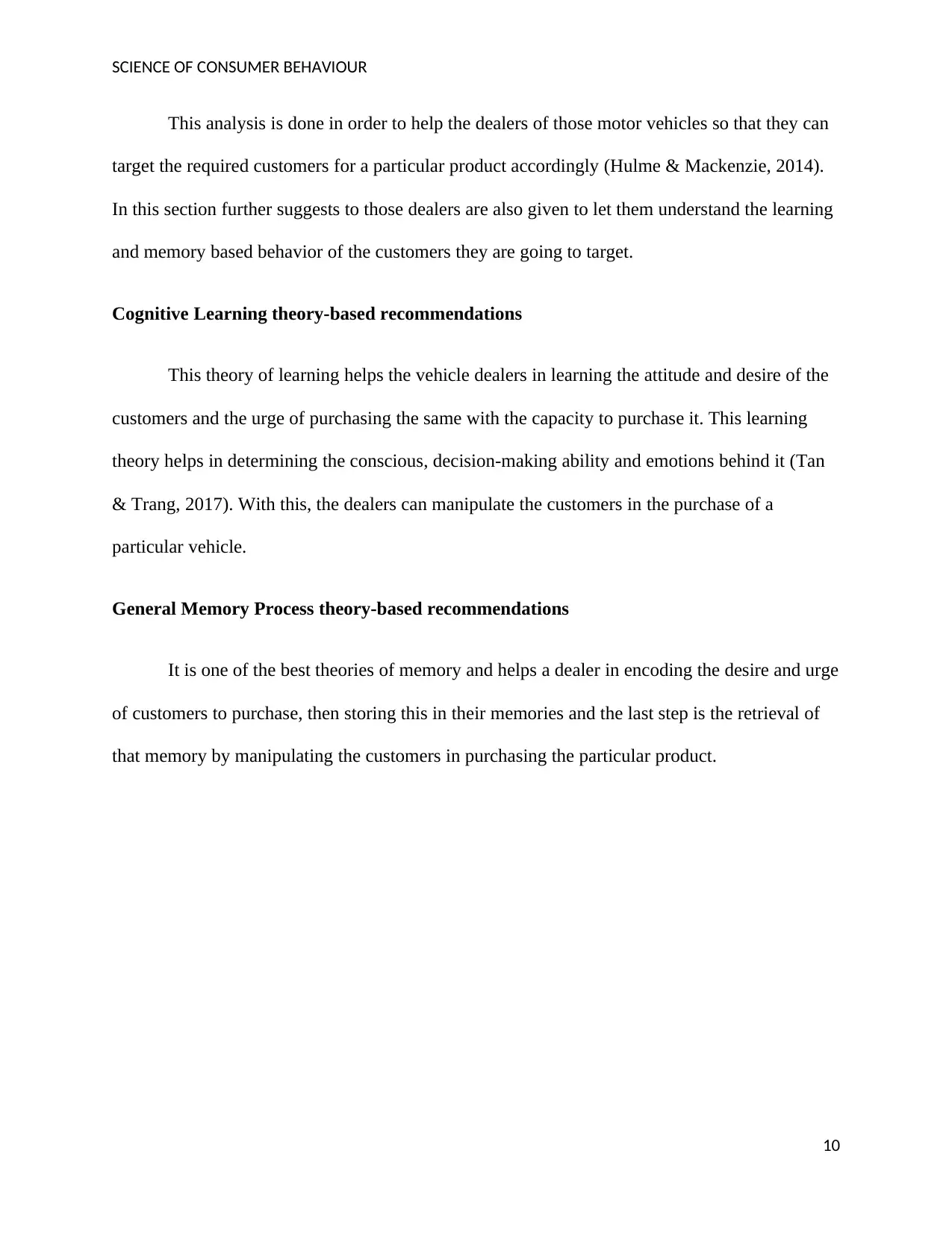
SCIENCE OF CONSUMER BEHAVIOUR
This analysis is done in order to help the dealers of those motor vehicles so that they can
target the required customers for a particular product accordingly (Hulme & Mackenzie, 2014).
In this section further suggests to those dealers are also given to let them understand the learning
and memory based behavior of the customers they are going to target.
Cognitive Learning theory-based recommendations
This theory of learning helps the vehicle dealers in learning the attitude and desire of the
customers and the urge of purchasing the same with the capacity to purchase it. This learning
theory helps in determining the conscious, decision-making ability and emotions behind it (Tan
& Trang, 2017). With this, the dealers can manipulate the customers in the purchase of a
particular vehicle.
General Memory Process theory-based recommendations
It is one of the best theories of memory and helps a dealer in encoding the desire and urge
of customers to purchase, then storing this in their memories and the last step is the retrieval of
that memory by manipulating the customers in purchasing the particular product.
10
This analysis is done in order to help the dealers of those motor vehicles so that they can
target the required customers for a particular product accordingly (Hulme & Mackenzie, 2014).
In this section further suggests to those dealers are also given to let them understand the learning
and memory based behavior of the customers they are going to target.
Cognitive Learning theory-based recommendations
This theory of learning helps the vehicle dealers in learning the attitude and desire of the
customers and the urge of purchasing the same with the capacity to purchase it. This learning
theory helps in determining the conscious, decision-making ability and emotions behind it (Tan
& Trang, 2017). With this, the dealers can manipulate the customers in the purchase of a
particular vehicle.
General Memory Process theory-based recommendations
It is one of the best theories of memory and helps a dealer in encoding the desire and urge
of customers to purchase, then storing this in their memories and the last step is the retrieval of
that memory by manipulating the customers in purchasing the particular product.
10
Paraphrase This Document
Need a fresh take? Get an instant paraphrase of this document with our AI Paraphraser
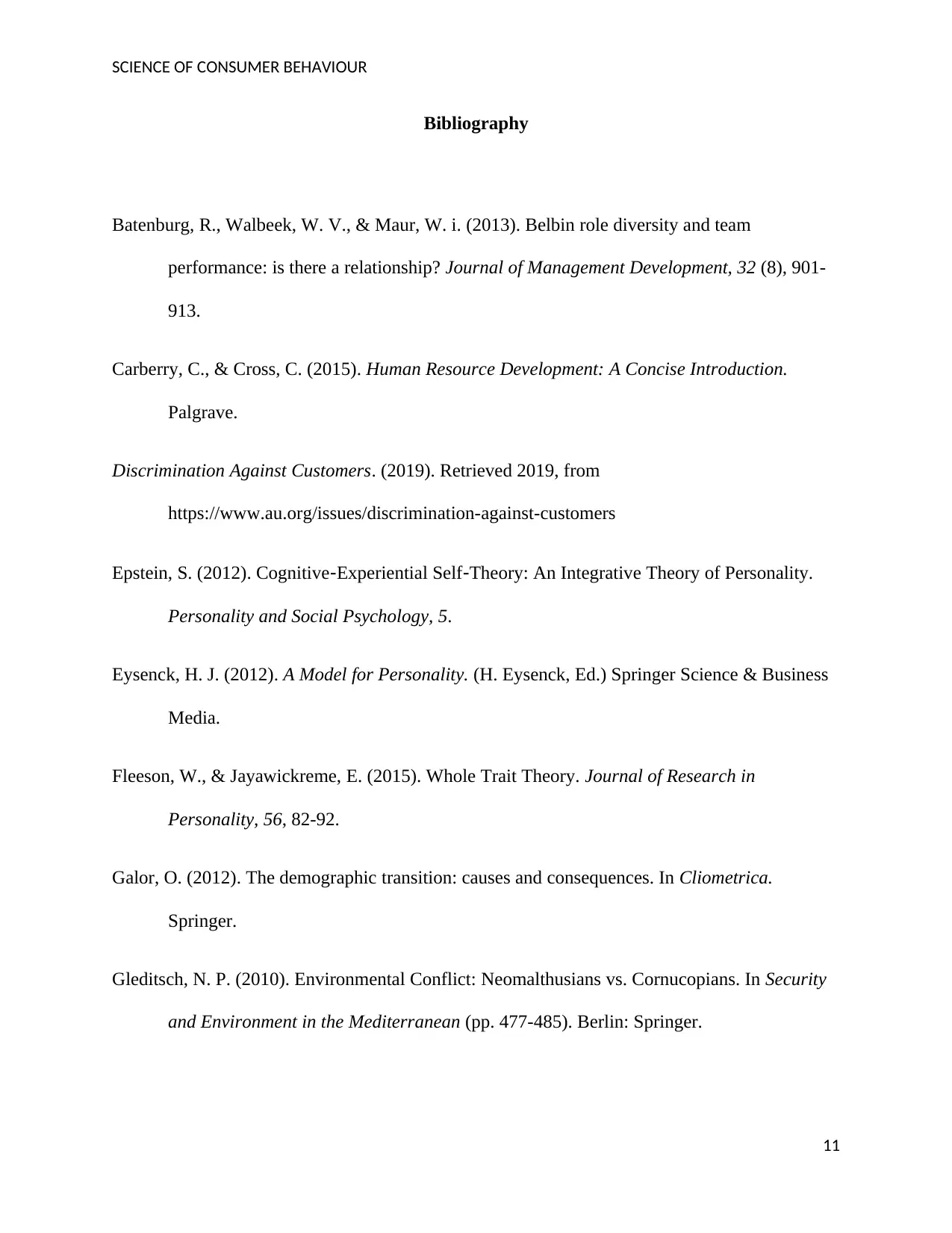
SCIENCE OF CONSUMER BEHAVIOUR
Bibliography
Batenburg, R., Walbeek, W. V., & Maur, W. i. (2013). Belbin role diversity and team
performance: is there a relationship? Journal of Management Development, 32 (8), 901-
913.
Carberry, C., & Cross, C. (2015). Human Resource Development: A Concise Introduction.
Palgrave.
Discrimination Against Customers. (2019). Retrieved 2019, from
https://www.au.org/issues/discrimination-against-customers
Epstein, S. (2012). Cognitive‐Experiential Self‐Theory: An Integrative Theory of Personality.
Personality and Social Psychology, 5.
Eysenck, H. J. (2012). A Model for Personality. (H. Eysenck, Ed.) Springer Science & Business
Media.
Fleeson, W., & Jayawickreme, E. (2015). Whole Trait Theory. Journal of Research in
Personality, 56, 82-92.
Galor, O. (2012). The demographic transition: causes and consequences. In Cliometrica.
Springer.
Gleditsch, N. P. (2010). Environmental Conflict: Neomalthusians vs. Cornucopians. In Security
and Environment in the Mediterranean (pp. 477-485). Berlin: Springer.
11
Bibliography
Batenburg, R., Walbeek, W. V., & Maur, W. i. (2013). Belbin role diversity and team
performance: is there a relationship? Journal of Management Development, 32 (8), 901-
913.
Carberry, C., & Cross, C. (2015). Human Resource Development: A Concise Introduction.
Palgrave.
Discrimination Against Customers. (2019). Retrieved 2019, from
https://www.au.org/issues/discrimination-against-customers
Epstein, S. (2012). Cognitive‐Experiential Self‐Theory: An Integrative Theory of Personality.
Personality and Social Psychology, 5.
Eysenck, H. J. (2012). A Model for Personality. (H. Eysenck, Ed.) Springer Science & Business
Media.
Fleeson, W., & Jayawickreme, E. (2015). Whole Trait Theory. Journal of Research in
Personality, 56, 82-92.
Galor, O. (2012). The demographic transition: causes and consequences. In Cliometrica.
Springer.
Gleditsch, N. P. (2010). Environmental Conflict: Neomalthusians vs. Cornucopians. In Security
and Environment in the Mediterranean (pp. 477-485). Berlin: Springer.
11
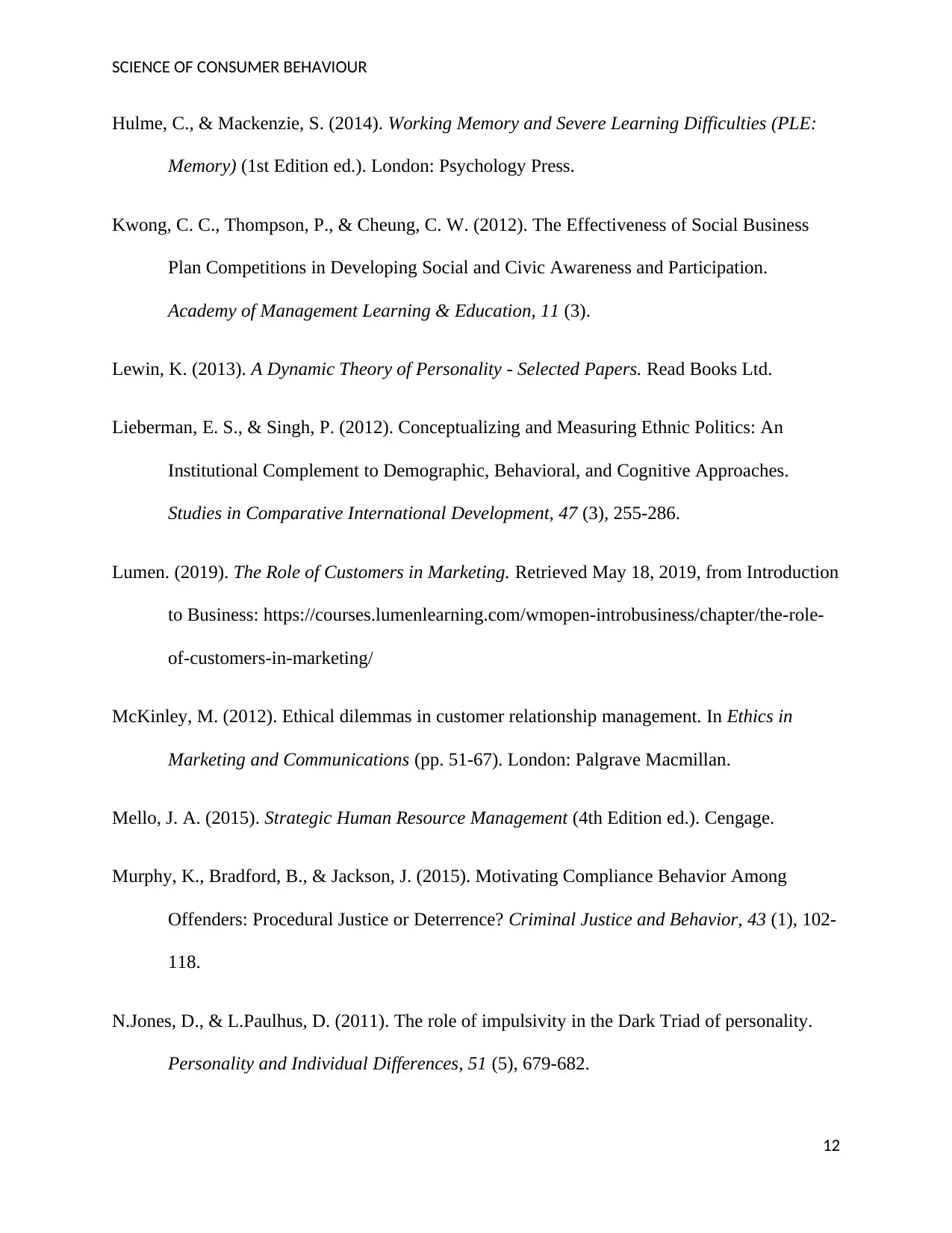
SCIENCE OF CONSUMER BEHAVIOUR
Hulme, C., & Mackenzie, S. (2014). Working Memory and Severe Learning Difficulties (PLE:
Memory) (1st Edition ed.). London: Psychology Press.
Kwong, C. C., Thompson, P., & Cheung, C. W. (2012). The Effectiveness of Social Business
Plan Competitions in Developing Social and Civic Awareness and Participation.
Academy of Management Learning & Education, 11 (3).
Lewin, K. (2013). A Dynamic Theory of Personality - Selected Papers. Read Books Ltd.
Lieberman, E. S., & Singh, P. (2012). Conceptualizing and Measuring Ethnic Politics: An
Institutional Complement to Demographic, Behavioral, and Cognitive Approaches.
Studies in Comparative International Development, 47 (3), 255-286.
Lumen. (2019). The Role of Customers in Marketing. Retrieved May 18, 2019, from Introduction
to Business: https://courses.lumenlearning.com/wmopen-introbusiness/chapter/the-role-
of-customers-in-marketing/
McKinley, M. (2012). Ethical dilemmas in customer relationship management. In Ethics in
Marketing and Communications (pp. 51-67). London: Palgrave Macmillan.
Mello, J. A. (2015). Strategic Human Resource Management (4th Edition ed.). Cengage.
Murphy, K., Bradford, B., & Jackson, J. (2015). Motivating Compliance Behavior Among
Offenders: Procedural Justice or Deterrence? Criminal Justice and Behavior, 43 (1), 102-
118.
N.Jones, D., & L.Paulhus, D. (2011). The role of impulsivity in the Dark Triad of personality.
Personality and Individual Differences, 51 (5), 679-682.
12
Hulme, C., & Mackenzie, S. (2014). Working Memory and Severe Learning Difficulties (PLE:
Memory) (1st Edition ed.). London: Psychology Press.
Kwong, C. C., Thompson, P., & Cheung, C. W. (2012). The Effectiveness of Social Business
Plan Competitions in Developing Social and Civic Awareness and Participation.
Academy of Management Learning & Education, 11 (3).
Lewin, K. (2013). A Dynamic Theory of Personality - Selected Papers. Read Books Ltd.
Lieberman, E. S., & Singh, P. (2012). Conceptualizing and Measuring Ethnic Politics: An
Institutional Complement to Demographic, Behavioral, and Cognitive Approaches.
Studies in Comparative International Development, 47 (3), 255-286.
Lumen. (2019). The Role of Customers in Marketing. Retrieved May 18, 2019, from Introduction
to Business: https://courses.lumenlearning.com/wmopen-introbusiness/chapter/the-role-
of-customers-in-marketing/
McKinley, M. (2012). Ethical dilemmas in customer relationship management. In Ethics in
Marketing and Communications (pp. 51-67). London: Palgrave Macmillan.
Mello, J. A. (2015). Strategic Human Resource Management (4th Edition ed.). Cengage.
Murphy, K., Bradford, B., & Jackson, J. (2015). Motivating Compliance Behavior Among
Offenders: Procedural Justice or Deterrence? Criminal Justice and Behavior, 43 (1), 102-
118.
N.Jones, D., & L.Paulhus, D. (2011). The role of impulsivity in the Dark Triad of personality.
Personality and Individual Differences, 51 (5), 679-682.
12
⊘ This is a preview!⊘
Do you want full access?
Subscribe today to unlock all pages.

Trusted by 1+ million students worldwide
1 out of 13
Related Documents
Your All-in-One AI-Powered Toolkit for Academic Success.
+13062052269
info@desklib.com
Available 24*7 on WhatsApp / Email
![[object Object]](/_next/static/media/star-bottom.7253800d.svg)
Unlock your academic potential
Copyright © 2020–2025 A2Z Services. All Rights Reserved. Developed and managed by ZUCOL.




